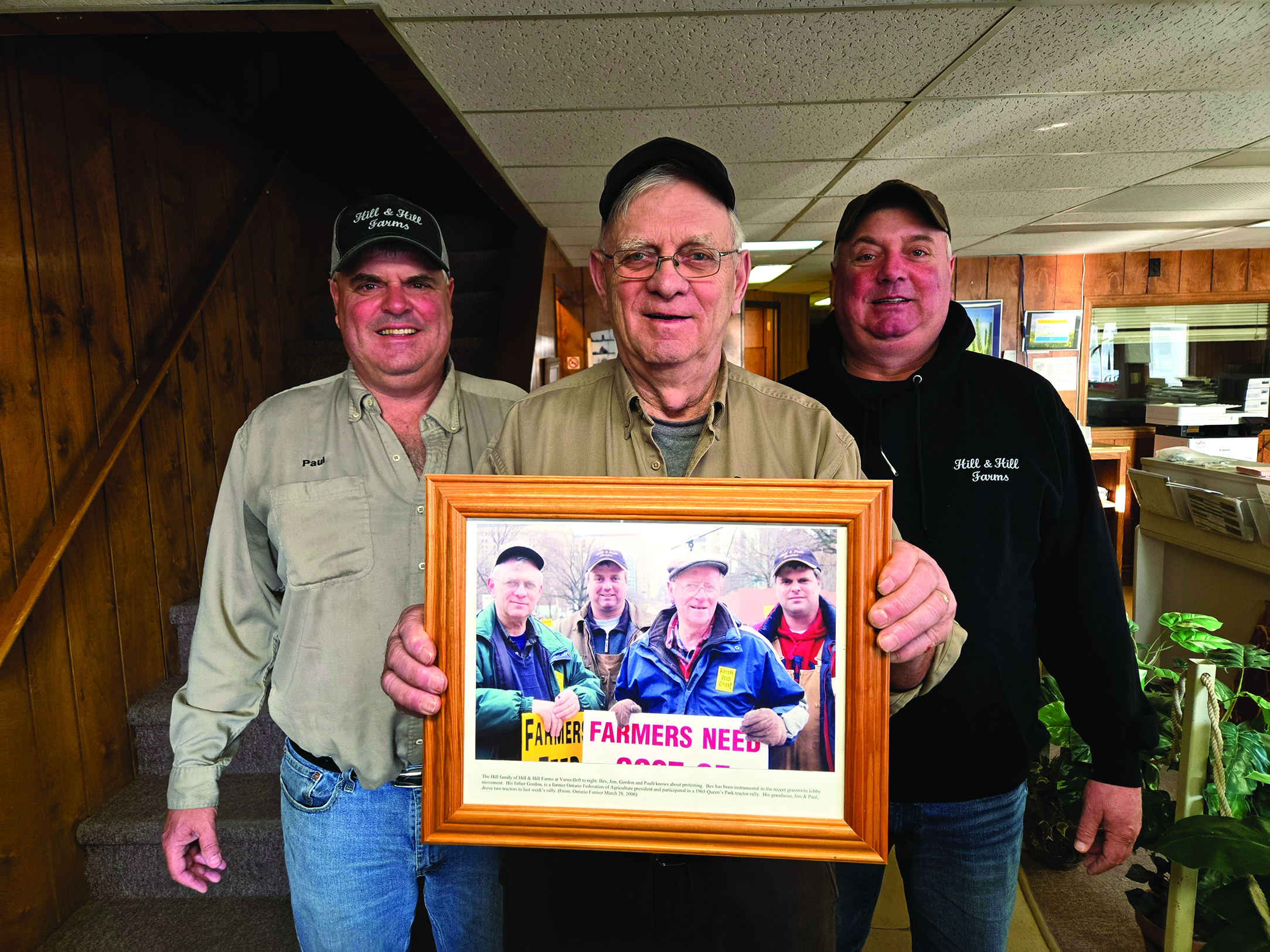This month, we are going back in time another 10 years to the April 2005 issue. Many of you will remember that 20 years ago was a difficult time for many farmers. It had been two years since a case of BSE had led to border closures to beef cattle and the cattle industry was hurting badly. Commodity prices were on a downward trend, rumours that farmland prices were dropping, the Canadian dollar was at U.S.D. $0.77.
And not only were the U.S. borders closed from the BSE crisis, but our community was still reeling from the Walkerton water tragedy in 2000, along with the 911 attack on the World Trade Centre in 2001 and the subsequent wars in Afghanistan and Iraq.
And the biggest story of the April 2005 issue was the One Voice March that had happened the previous month, in Queen’s Park in Toronto. Keith Roulston wrote the feature article on the topic, and it was also addressed in the Federation newsletters and John Beardsley’s column.
There were a few buses that left Huron, Perth and neighbouring counties that morning of March 2, 2005, joining the 8,000 people there at Queen’s Park. It was bitterly cold that day, that much everyone remembers.
It had been “tough sledding” for the previous five years, says John Beardsley. Prices were below the cost of production and while the larger farmers were maybe getting by, the small and medium farmers were definitely getting very stressed. And it meant that equipment suppliers were also getting worried, realizing that local communities benefit from stable incomes. Even a local restaurant owner was mentioned in Keith Roulston’s article, saying that his business was down because local farmers weren’t coming in.

The Hills remember the day well. Bev had driven to Toronto with his father and long-time farm organizer, Gord Hill, while his two sons, Jim and Paul, each drove a tractor into the city. They remember borrowing a trailer from Merner Contracting to float two John Deeres (a 4230 and a 4240) to John Doner's (1945-2021) farm near King City. From there, a whole line of tractors went south into the city, right downtown.
“It was surreal to see the CN Tower and Skydome from the seat of a tractor,” says Jim.
Nick Whyte is a poultry producer near Seaforth and was President of the Huron County Federation of Agriculture at the time and recalls that the grassroots federations were putting pressure on the OFA to organize.
“There was no shortage of disappointed people,” says Nick. It was getting so that kids weren’t even considering a career on the family farm. He recalls that the County Federations helped to organized busloads of farmers from all parts of the province. He and his wife Joan boarded the bus that morning from the government office in Clinton. Joan remembers that the back seat of the bus was filled with yellow signs with black letters.
Larry and Nancy Skinner boarded the bus for Queen’s Park from the Listowel Agricultural Hall that morning. Larry is a Perth County pork producer and was Chair of Ontario Pork at the time. Although Larry’s prepared speech is long gone, he remembers that all the farm organizations had the same message that day, and there were lots of media at the event.
Our government representatives had often complained that different commodity groups were asking for different things and that if we would just have one voice and one message, it would be a lot easier to accommodate our requests, said Larry. So, they did.
And they had looked to Quebec that had one strong, seemingly united, farm organization and the amount of support programming their farmers had. So, they decided to march to Queen’s Park in Toronto and, organization by organization, they stood up to ask the government for assistance to avert a financial catastrophe. They asked for $300 million in short-term support just to get crops planted over the next months.
Paul Steckle was the Huron-Perth Member of Parliament and chair of the agricultural committee at the time; he was at the rally, defending his actions and his government. According to the 2005 Rural Voice article, Steckle claimed that federal support for farmers had increased from $2.2 billion in 2001 to $4.8 billion in 2005. He said that he had done far from nothing for farmers during his time as MP, but that he had driven the agricultural agenda further than it had ever been. “I have given you every expendable ounce of energy,” Steckle said in the article.
For John, he remembered chatting with his taxi driver that day, and felt that the people of Toronto were quite sympathetic to the farmers’ protest. “I didn’t know that farmers weren’t making money,” the driver had said.
Bright yellow signs would soon become the brand of the Farmers Feed Cities campaign in 2005. This campaign was initiated by a coalition of commodity groups that would soon join to become the Grain Farmers of Ontario in 2009. The Farmers Feed Cities campaign lasted for nearly 10 years and involved consumer education, before the GFO pivoted to build a brand for themselves, Good in Every Grain. In a 2014 article for Real Agriculture, Owen Roberts suggested that the campaign had been a big hit and that the “you need us” message had resonated with consumers during the later 2000s.
“But when grain prices started rising — and kept rising — and farm incomes reached record levels, the angry farmer image lost its lustre,” wrote Roberts. “Negativity diminished.” And, for now, the Farmers Feed Cities posters and stickers are collectible memorabilia.
Considering the bad news that farmer protesters received about the border closures on the way back home from the 2005 protest, farmers may have felt that all that standing around in the freezing cold all day was for nought. But, many said that the suite of Business Risk Management programs that came out in the years following the One Voice March have served farmers well to this day. AgriStability, in particular, is set up to provide income insurance that would help farmers weather the ups and downs of the market. Although some suggest that a farmer would need to be nearly bankrupt in order to make a claim.
“At the end of the day, it was worth doing,” concludes Nick Whyte. “We felt the politicians knew we were there and why.”
With uncertain times ahead (again), will we see another farmer protest? Most think it would be unlikely. Some questioned whether our commodity groups and farm organizations would have the guts to organize something like that again, considering that their funding is at the mercy of government legislation. There was also concern that some of our farm organizations are no longer non-partisan.
The plight of farmers in 2005 was even discussed at Mabel’s Grill that month. Cliff, George and Dave were discussing how Wiarton Willy’s early spring prediction was wrong, frustration with the U.S. keeping the border closed and the notion of paying for their breakfast with corn instead of cash. Mabel had replied, “Only if you want nothing but cornbread for the next two years.” Oh, Mabel.
An interesting letter to the editor had come in that month from Alvin Filsinger of Ayton, discussing the ways that organic standards were being inflexible and hurting organic growers. Alvin had been growing and processing apples, among other fruits, since 1939. He was 80 years old when he wrote the letter and went on to sell the 100-acre farm the following year, in 2006. It was bought by locals, Shaun Becker, Cory Becker, Deb Becker and Brandon Weber. The Rural Voice caught up with Shaun, who says he was 28 years old at the time. He laughs that it was a good thing he didn’t know how much work it would be, or else he might not have done it.
For a while, the new team managed the farm as a hobby because they all had other jobs, but they started to lean into high density production and growing their processing and product lines over the last decade. They are becoming a household name for their apple cider vinegar and are now exporting to various parts of the world as well. It looks like the Rural Voice will have to do a feature article on this incredible local story! But for now, suffice it to say that Shaun agrees that organic standards are constantly evolving, and they have continued to do all the necessary paperwork to keep Filsinger’s organic certification.
Alvin Filsinger passed away in 2010. There are about four acres of his original apple trees that are still in production on the property. He was one of the first organic farms in Canada and he was awarded the Lifetime Organic Hero Award by the Canadian Organic Growers in 2008.
Another article in that issue was about Susan and Bert Buffinga’s new free stall dairy barn with a double-eight herringbone parlour. Susan says that they haven’t had to make many changes to the barn, except that they now have bunk silos instead of upright ones. There is a lot more paperwork to do now, she admits, for better or worse.
As for the Buffinga family, their oldest son has moved to the Atlantic provinces to farm, their daughter is farming with her husband nearby and her youngest son is working with them on the farm. He has moved onto the home farm now with his family and Susan and Bert have moved to a house on the corner of the property. “They call it the retirement house, but we’re not really retired,” jokes Susan. She and Bert now have eight grandchildren. A lot can change in 20 years!
The April 2005 issue also featured an article on pig barns, animal welfare and loose housing, with research from the Prairie Swine Centre. The Rural Voice caught up with Doug Ahrens, a Perth county pork producer who was a long-time board member of Ontario Pork and was instrumental in stick-handling the Pig Code with the National Farm Animal Care Council in 2014.
In reading through the 2005 article again after all these years, it sounded archaic, Doug said. Some of the sorting technology they suggested isn’t relevant anymore. Floor feeding makes pigs aggressive, so nearly all producers have opted for electronic feeders that can ration food and remove the need for aggression. As well, the genetics have changed, and pigs are bred to be less aggressive, allowing more opportunities for loose housing.
Changing the code for pig barns was a huge undertaking and while there was support for research, says Doug, not a dime was spent helping pork producers make modifications to their barns. “Producers are doing this one on their own,” he said.
Rhea was writing her gardening column, and it was just as playful as it is now. In April 2005, she was way ahead of her time, discussing Asian vegetables for the garden, many of which were featured in last month’s article by Shiying Li.
And yes, an even younger-looking Steve Bowers was writing 20 years ago. He was still working for the Ministry of Nature Resources at the time, and his column described some of the concerns with Genetically Engineered (GE) trees. It doesn’t seem that GE trees are discussed much these days, but perhaps that will be a story for another issue.
Inductees to the Agricultural Hall of Fame in 2005 included Huron County’s Murray Gaunt (1935-2009), Brian Scott Ellsworth (1933-2022), M. Birdell Hind (1901-1973), Garnet Alvin Ralph (1924-2016), and Clayton Switzer (1929-2024).
As we step back in time over the next few issues, it gets more humbling both how much and how little can change in 20 years. ◊

